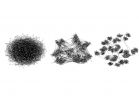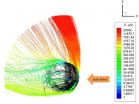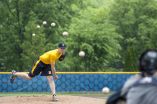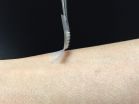(Press-News.org) Social networks affect every aspect of our lives, from the jobs we get and the technologies we adopt to the partners we choose and the healthiness of our lifestyles. But where do they come from?
In a new study, the University of Pennsylvania's Damon Centola shows how social networks form and what that means for the ideas that will spread across them.
Counterintuitively, he finds that breaking down group boundaries to increase the spread of knowledge across populations may ultimately result in less-effective knowledge sharing. Instead, his research shows that best practices and complex ideas are more readily integrated across populations if some degree of group boundaries is preserved.
The findings suggest that a policy to increase integration in the workplace by doing away with ethnically affiliated clubs, for example, could actually reduce the likelihood that ideas and beliefs would be shared across the company. The work has implications for institutional attempts to increase diversity, businesses' efforts to spread shared values and organizations interested in integrating solutions to complex problems.
Centola is an associate professor in Penn's Annenberg School for Communication and School of Engineering and Applied Science and is director of the Network Dynamics Group at Penn. His work is published in the American Journal of Sociology.
The work builds off foundational research by social theorists Peter Blau and Joseph Schwartz. In 1984, they argued that societies in which group affiliations were eliminated would enjoy the greatest levels of social integration. A direct implication of their theory was that social policies that reduce group boundaries would create the most opportunities for complex ideas and shared knowledge to spread across a society.
In the current work, Centola revisited Blau and Schwartz's theories using a new computational model to understand how social affiliations create networks and, in turn, how complex ideas and shared practices can diffuse through those networks.
The model assumed that each individual's personal and professional characteristics (e.g., gender, race, religion, income, education, political party, preferred recreational activities, residential neighborhood, etc.) define that person's identity. The structure of a society is determined by the extent to which different characteristics are correlated with one another. For instance, if a person knows another's religion, income and education, can he or she also predict the neighborhood where that person lives?
Centola's experiments with the model showed that these correlations have striking implications for the social networks that emerge.
"The results are surprisingly clear," Centola said. "The stronger these correlations are, the more 'grouped' the entire social network is. Small changes in the correlations between two characteristics, for instance religion and residential neighborhood, have large consequences for the 'groupiness' of the social network."
The analysis also revealed a twist on Blau and Schwartz's work. As Blau and Schwartz predicted, reducing group boundaries increased the likelihood that complex ideas could diffuse across a population, but only up to a point.
"When a society is too grouped, people do not have any social contact with people from other groups," Centola said. "People with the same job all attended the same school, live in the same neighborhood and frequent the same clubs. Their networks do not expand beyond that group."
Loosening these tight group boundaries means that people's next-door neighbors may have different jobs or levels of education, but they may still have similar politics or recreational activities. These similarities allow people in different social groups to encourage the adoption of a new complex idea, take neighborhood recycling as an example, which can then spread to other neighborhoods and social groups.
But when group boundaries are eliminated entirely, people have almost nothing in common with their neighbors and therefore very little influence over one another, making it impossible to spread complex ideas.
"There's a belief that the more that people interact with strangers, the more that new ideas and beliefs will spread," Centola said. "What this study shows is that preserving group boundaries is actually necessary for complex ideas to become accepted across diverse populations."
This is especially true for adopting new solutions to hard problems. In business settings, for example, a new piece of information about a stock price might not require strong social reinforcement in order to spread. But a more nuanced idea, such as what is considered an acceptable way to conduct business or how to respond to a new "green" initiative, can require strong social support to diffuse throughout a company. The success of a new initiative can depend upon group structures that can grow widespread support across a large organization.
Centola further noted that these kinds of structures, in which group boundaries exist but overlap to some degree, are naturally occurring on the Internet. Distinct online communities sprout up among people with common interests, yet these groups also have interconnections across their membership.
"It could be that the Internet is in fact set up and operates in such a way as to allow easier coordination on complex ideas," he said.
INFORMATION:
This study was supported in part by the James S. McDonnell Foundation.
CORVALLIS, Ore. - A study at Oregon State University indicates that both a high-fat and a high-sugar diet, compared to a normal diet, cause changes in gut bacteria that appear related to a significant loss of "cognitive flexibility," or the power to adapt and adjust to changing situations.
This effect was most serious on the high-sugar diet, which also showed an impairment of early learning for both long-term and short-term memory.
The findings are consistent with some other studies about the impact of fat and sugar on cognitive function and behavior, and suggest that ...
If planets had personalities, Mars would be a rock star according to recent preliminary results from NASA's MAVEN spacecraft. Mars sports a "Mohawk" of escaping atmospheric particles at its poles, "wears" a layer of metal particles high in its atmosphere, and lights up with aurora after being smacked by solar storms. MAVEN is also mapping out the escaping atmospheric particles. The early results are being discussed at a MAVEN-sponsored "new media" workshop held in Berkeley, California, on June 19-21.
The Mars Atmosphere and Volatile Evolution (MAVEN) spacecraft was launched ...
COLUMBIA, Mo. - In 1964, renowned biologists Peter Raven and Paul Erhlich published a landmark study that introduced the concept of co-evolution. Using butterflies and plants as primary examples, the team determined that two species can reciprocally drive each other's evolution and development. Now, an international team of researchers led by the University of Missouri and Stockholm University has used cutting-edge genomics to analyze the co-evolution theory and identified the mechanisms responsible for this phenomenon. Scientists believe that understanding how co-evolution ...
Our brains track moving objects by applying one of the algorithms your phone's GPS uses, according to researchers at the University of Rochester. This same algorithm also explains why we are fooled by several motion-related optical illusions, including the sudden "break" of baseball's well known "curveball illusion."
The new open-access study published in PNAS shows that our brains apply an algorithm, known as a Kalman filter, when tracking an object's position. This algorithm helps the brain process less than perfect visual signals, such as when objects move to the ...
Amid reports that rank today's teens as the most stressed generation in the country, a new study offers hope for helping them effectively manage stress and build long-term resiliency. A pilot study, published in the spring issue of the journal Advances in Mind-Body Medicine, describes how a stress-reduction/resiliency-building curriculum developed by the Benson-Henry Institute (BHI) at Massachusetts General Hospital (MGH) helped a group of Boston-area high school students significantly reduce their anxiety levels, increase productivity and effectively manage stress over ...
PROVIDENCE, R.I. [Brown University] -- Fish are power eaters. In many species, large muscles running along their backs and bellies provide bursts of speed for chasing down prey. Then, at the very instant they close in, they vacuum victims into their suddenly gaping mouths with overwhelming suction. It turns out that these power surges are no anatomical coincidence. A new study shows that largemouth bass get their slurping power from the very same muscles that provide their swimming power.
In the Proceedings of the National Academy of Sciences, Brown University researchers ...
Chemists and biologists at UC San Diego have succeeded in designing and synthesizing an artificial cell membrane capable of sustaining continual growth, just like a living cell.
Their achievement, detailed in a paper published in this week's issue of the Proceedings of the National Academy of Sciences, will allow scientists to more accurately replicate the behavior of living cell membranes, which until now have been modeled only by synthetic cell membranes without the ability to add new phospholipids.
'The membranes we created, though completely synthetic, mimic several ...
WASHINGTON (June 18, 2015) -- Research published in the Proceedings of the National Academy of Sciences found that some individuals exposed to HIV-1, but who remain uninfected, have a certain pattern of virus-specific immune responses that differentiated them from individuals who became infected. The findings build upon prior research by studying these responses in the context of a controlled clinical trial, examining a large number of subjects, and by having access to specimens saved before anyone was infected. In the future, this information could be used to assess HIV-1 ...
CHAPEL HILL, NC - Painful insulin injections could become a thing of the past for the millions of Americans who suffer from diabetes, thanks to a new invention from researchers at the University of North Carolina and NC State, who have created the first "smart insulin patch" that can detect increases in blood sugar levels and secrete doses of insulin into the bloodstream whenever needed.
The patch - a thin square no bigger than a penny - is covered with more than one hundred tiny needles, each about the size of an eyelash. These "microneedles" are packed with microscopic ...
New Vanderbilt-led research shows hospitals are doing a better job of using antibiotics less commonly associated with antibiotic resistance to treat children hospitalized with community-acquired pneumonia (CAP).
The report, 'Antibiotic choice for children hospitalized with pneumonia and adherence to national guidelines,' was released today in the journal Pediatrics.
This study was nested within a larger study, the Centers for Disease Control and Prevention (CDC) Etiology of Pneumonia in the Community (EPIC). The multi-center EPIC study was a prospective, population-based ...





